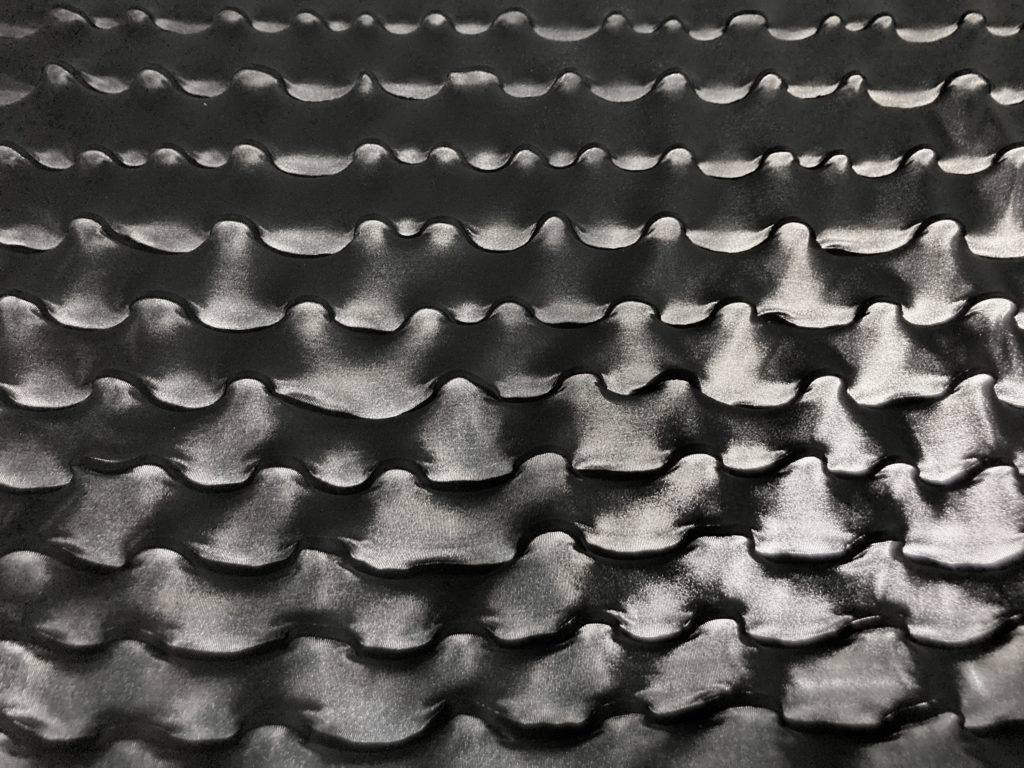Self-shaping Textiles
by: Agata Kycia and Dr. Lorenzo GuiducciSelf-shaping Textiles
Transfer of morphogenetic processes from plants to textiles
Nowadays, new digital modeling tools enable generation of complex geometries where materials are shaped by digital fabrication technologies, for example by additive manufacturing. This approach often leads to a discrepancy between the pure form and its materiality. Instead, both textile manufacturing techniques and biomaterials research have shown a multitude of physical surfaces whose three-dimensional shape results from the interplay between material properties and forces acting on them.
Our project focuses on the creation of meter-scale surface structures by transforming 2D surfaces into 3D wrinkled structures. We are inspired by the morphogenetic processes in plant leaves, where complex three-dimensional surfaces originate from in-plane growth distributions and propose the use of 3D printing (or any other solid deposition method) on pre-stretched textiles as an alternative, material based form-finding technique. Although the formation processes are different in both cases (leaves fold due to growth process and textiles due to shrinkage), we replace growth with elasticity-inhomogeneity in the material, as the three-dimensional transformation is based on the same principle.
We deposit flexible polymeric material in the form of line bundles and discover a variety of wavy shapes that occur once the fabric tension is released. Our work is an exploration on geometry and materiality serving as design drivers for the creation of three-dimensional textile surfaces. Indeed, these textiles exhibit a variety of optical and elastic properties promoting numerous visual and tactile sensations on the spectator. The effects of gravity or tensioning can further contribute to the complex appearance which changes drastically depending on the staging conditions such as lighting or hanging. We highlight such multifaceted character by placing these surfaces next to their bulk fully plastic 3D printed replicas. This juxtaposition is meant to provoke the visitors by challenging their perception of both models, leaving them to contrast, compare and wonder, whether there is –or maybe not- much more than shape to these textiles.
Agata Kycia is a Berlin based architect and researcher fascinated by the potential intersections of computational design, digital fabrication and material science. She worked for several years as lead architect at HENN in Berlin and lectured at various universities such as TU Delft, Architectural Association VS, Warsaw School of Architecture, Fachhochschule Düsseldorf, Fab Lab Berlin, TU Berlin-CHORA, IaaC Barcelona and IED Madrid. Currently she’s teaching and researching at the weißensee kunsthochschule berlin and TU Berlin, where she investigates material-informed design strategies through 3D printing on textiles.
Lorenzo Guiducci is a biomedical engineer, teaching and conducting research at the intersection of science, design and architecture. He obtained a PhD in Physics (Max Planck Institute for Colloids and Interfaces, University of Potsdam) for his work on the actuation principles of pressurized cellular tissues in plant seed capsules. He is currently co-leading the Material Form Function group at Matters of Activity Cluster of Excellence (Humboldt Universität zu Berlin) and further investigating shape-changing materials and mechanical metamaterials such as 3D printed textiles, auxetics and kirigami.

